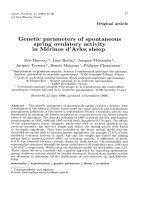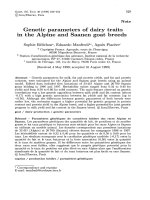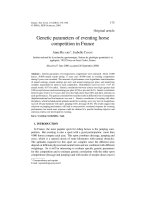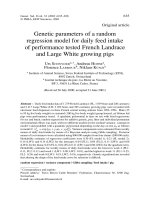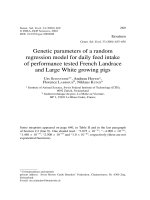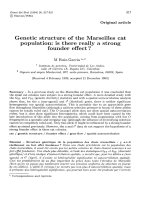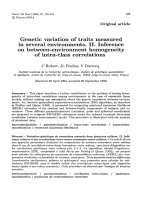Báo cáo sinh học: "Genetic parameters of feeding behaviour and performance traits in group-housed Large White and French Landrace" pps
Bạn đang xem bản rút gọn của tài liệu. Xem và tải ngay bản đầy đủ của tài liệu tại đây (976 KB, 18 trang )
Original
article
Genetic
parameters
of
feeding
behaviour
and
performance
traits
in
group-housed
Large
White
and
French
Landrace
growing
pigs
F
Labroue
R
Guéblez
P
Sellier
1
Département
de
génétique
animale,
Station
de
génétique
quantitative
et
appliquée,
Institut
national
de
la
recherche
agronomique,
78352
Jouy-en-Josas
cedex;
2
Institut
technique
du
porc,
La
Motte
au
Vicomte,
BP
33,
35651
Le
Rheu
cedex,
France
(Received
2
November
1996;
accepted
14
August
1997)
Summary -
Data
on
feeding
behaviour
of
3
710
group-housed
and
ad
libitum
fed
growing
pigs
were
recorded
using
’Acema
48’
electronic
feed
dispensers.
Genetic
parameters
for
six
feeding
behaviour
criteria
and
the
main
production
traits
routinely
recorded
in
French
central
test
stations
(three
’boar’
traits
and
three
’sib’
traits)
were
estimated
in
two
breeds
(Large
White
and
French
Landrace)
using
a
multiple
trait
animal
model
DF-REML
procedure.
Heritability
estimates
for
feeding
behaviour
criteria
ranged
from
0.36
to
0.54
and
were
markedly
higher
than
that
for
the
food
conversion
ratio
(0.20).
Heritability
of
daily
feed
intake
was
0.42
in
both
breeds,
whereas
heritabilities
of
rate
of
feed
intake,
feed
intake
per
meal
and
time
per
meal
were
slightly
higher
(0.45-0.54).
Daily
feed
intake
showed
a
very
close
genetic
correlation
(around
0.85)
with
average
daily
gain
but
also
unfavourable
genetic
correlations
with
ultrasonic
backfat
thickness
(around
0.5)
and
lean
percentage
(around
-0.4).
Daily
feed
intake
was
genetically
independent
of food
conversion
ratio,
whereas
average
daily
gain
showed
a
favourable
genetic
correlation
(around
-0.35)
with
that
trait.
Among
the
feeding
behaviour
criteria,
feed
intake
per
meal
and
rate
of
feed
intake
showed
the
highest
genetic
correlations
with
daily
feed
intake
(around
0.5)
and
average
daily
gain
(around
0.4).
They
also
showed
moderately
unfavourable
genetic
correlations
with
ultrasonic
backfat
thickness
(around
0.25)
and
carcass
lean
percentage
(around
-0.25)
and
seemed
to
be
genetically
independent
of
food
conversion
ratio.
The
value
of
including
a
trait
relating
to
feed
intake
pattern
among
traits
selected
for
is
discussed
on
the
basis
of
this
set
of
genetic
parameters.
pig
/
genetic
parameter
/
feeding
behaviour
/
electronic
feed
dispenser
/
production
trait
*
Correspondence
and
reprints
Résumé -
Paramètres
génétiques
des
critères
de
comportement
alimentaire
et
des
performances
de
production
chez
des
porcs
Large
White
et
Landrace
français
élevés
en
groupe.
Les
données
de
comportement
alimentaire
de
3 710
porcs
en
croissance
élevés
en
groupes
et
alimentés
à
volonté
ont
été
récoltées
à
l’aide
de
distributeurs
automatiques
d’aliment
«Acema
48».
Les
paramètres
génétiques
de
six
critères
de
comportement
ali-
mentaire
et
des
principaux
caractères
de
production
mesurés
en
routine
dans
les
stations
publiques
de
contrôle
des
performances
(trois
caractères
« candidats
» et
trois
caractères
«
collatéraux»)
ont
été
estimés
dans
deux
races
(Large
White
et
Landrace
français)
à
l’aide
de
la
méthode
du
maximum
de
vraisemblance
restreinte
(REML)
appliquée
à
un
modèle
animal
multicaractère.
Les
héritabilités
des
critères
de
comportement
alimentaire
sont
com-
prises
entre
0,36
et
0,54,
et
sont
nettement
supérieures
à
celle
de
l’indice
de
consommation
(0,20).
L’héritabilité
de
la
consommation
moyenne
journalière
est
de
0,42
dans
chacune
des
deux
races
tandis
que
celles
de
la
vitesse
d’ingestion,
de
la
consommation
moyenne
par
repas
ou
de
la
durée
des
repas
sont
légèrement
plus
élevées
(0,45-0,54).
La
consommation
moyenne
journalière
présente
une
corrélation
génétique
très
élevée
(de
l’ordre
de
0,85)
avec
le
gain
moyen
quotidien
mais
aussi
des
corrélations
génétiques
défavorables
avec
l’épaisseur
de
lard
dorsal
(de
l’ordre
de
0,5)
et
le
pourcentage
de
muscle
(de
l’ordre
de
- 0,4).
La
consommation
moyenne
journalière
est
génétiquement
indépendante
de
l’indice
de
consommation
tandis
que
le
gain
moyen
quotidien
présente
une
corrélation
génétique
favorable
(de
l’ordre
de
-0,35)
avec
ce
caractère.
Parmi
les
critères
de
comportement
ali-
mentaire,
la
consommation
moyenne
par
repas
et
la
vitesse
d’ingestion
sont
les
plus
liées
génétiquement
à
la
consommation
moyenne
journalière
(environ
0,5)
et
au
gain
moyen
quotidien
(environ
0,4).
Ces
critères
présentent
également
des
corrélations
génétiques
modérément
défavorables
avec
l’épaisseur
de
lard
dorsal
(environ
0,25)
et
le
pourcent-
age
de
muscle
(environ -0,25)
et
semblent
être
génétiquement
indépendants
de
l’indice
de
consommation.
L’inclusion
possible
d’un
critère
de
comportement
alimentaire
parmi
les
caractères
sélectionnés
est
discutée
sur
la
base
de
cet
ensemble
de
paramètres
génétiques.
porc
/
paramètre
génétique
/
comportement
alimentaire
/
distributeur
automatique
d’aliment
/
caractère
de
production
INTRODUCTION
The
interest
in
studying
appetite
in
growing
pigs
raised
under
ad
libitum
feeding
conditions
has
grown
since
the
early
1980s
owing
to
the
genetic
trends
that
have
occurred
as
a
result
of
selection.
Pig
populations,
which
have
become
leaner
and
more
efficient
in
terms
of
converting
food
to
liveweight
gain,
generally
exhibit
lower
daily
feed
intake
(McPhee,
1981;
Mitchell
et
al,
1982;
Ellis
et
al,
1983;
Brandt,
1987;
Smith
et
al,
1991;
Cameron
and
Curran,
1994).
Such
a
decrease
in
daily
feed
intake
under
ad
libitum
feeding
conditions
could
limit
the
long-term
genetic
improvement
possible
for
daily
lean
tissue
deposition.
The
inclusion
of
daily
feed
intake,
or
any
other
feeding
behaviour
criterion,
among
breeding
goals
requires
the
knowledge
of
genetic
parameters
for
feeding
behaviour
criteria,
including
their
genetic
relationships
with
growth
rate,
feed
efficiency
and
carcass
lean
to
fat
ratio.
The
literature
review
made
by
Labroue
(1995)
concerning
the
appetite
of
growing
pigs
having
ad
libitum
access
to
feed,
showed
a
rather
large
variation
in
the
genetic
parameter
estimates,
especially
for
the
genetic
correlation
between
food
conversion
ratio
and
daily
feed
intake
(range
of
available
estimates:
0.01-1).
In
France,
three
central
test
stations
have
been
equipped
with
’Acema
48’
electronic
feed
dispensers
(Labroue
et
al,
1994b)
since
1990,
which
has
made
it
possible
to
collect
enough
data
to
study
the
genetic
variability
of
feeding
behaviour
criteria.
The
aim
of
the
present
study
was
to
estimate
genetic
parameters
of
the
Large
White
and
French
Landrace
breeds
for
feeding
behaviour
criteria
and
production
traits
using
a
restricted
maximum
likelihood
(REML)
procedure
applied
to
a
multi-trait
animal
model.
The
data
used
in
the
last
complete
estimation
of
genetic
parameters
for
production
traits
measured
in
French
central
test
stations
(Ducos
et
al,
1993)
were
collected
prior
to
the
establishment
of
electronic
feed
dispensers.
This
estimation
of
genetic
parameters
therefore
is
the
first
one
referring
to
the
new
central
testing
conditions
prevailing
in
France.
MATERIAL
AND
METHODS
Origin
of
data
Data
were
collected
on
Large
White
(LW)
and
French
Landrace
(LR)
pigs
at
three
French
central
test
stations
(Argentr6,
Le
Rheu,
Mauron)
between
1988
(beginning
of
ad
libitum
feeding
in
pens
of
around
12
pigs)
and
1994.
Since
1990,
most
pens
in
these
stations
have
been
equipped
with
an
’Acema
48’
feed
dispenser.
Feed
was
distributed
in
pellets
and
contained
9.0
MJ/kg
net
energy
and
170
g/kg
crude
protein.
During
this
period,
testing
was
performed
both
on
candidates
for
selection
(entire
males)
and
slaughtered
sibs
(castrated
males).
Breeders
usually
sent
one
triplet
of
pigs
(two
candidates
and
one
full-sib)
per
litter.
Animals
were
tested
in
successive
batches
(’all
in-all
out’
system),
each
batch
being
defined
as
a
group
of
contemporary
animals
entering
the
station
within
a
10-day
period,
having
similar
ages
and
liveweights
(around
30
days
and
7
kg,
respectively).
Young
boars
(candidates
for
selection)
were
tested
between
35
and
95
kg
liveweight.
Beginning
in
1990,
feed
intake
was
recorded
individually
throughout
the
test
period
(ie,
the
establishment
of
electronic
feed
dispensers).
Backfat
thick-
ness
was
measured
twice
at
the
end
of
the
test
at
liveweights
around
95
kg.
The
ultrasonic
measurements
were
taken
on
each
side
of
the
spine,
4
cm
from
the
mid-
dorsal
line
at
the
level
of
the
shoulder,
last
rib
and
hip
joint,
respectively.
Castrated
males
(sibs)
were
tested
between
35
and
100
kg
liveweight.
They
were
fed
ad
libitum
during
the
whole
test
period,
but
individual
feed
intake
was
not
recorded
on
all
sibs
in
two
stations.
At
these
stations,
the
boars
were
preferentially
raised
in
the
pens
equipped
with
an
electronic
feed
dispenser.
Sibs
were
slaughtered
in
a
commercial
abattoir
at
an
average
liveweight
of
100
kg.
On
the
day
after
slaughter,
a
standardized
cutting
of
one
half-carcass
was
performed
(Anonymous,
1990)
and
three
meat
quality
measurements
(ultimate
pH,
reflectance
and
water-
holding
capacity)
were
taken
on
ham
muscles
as
described
by
Tribout
et
al
(1996).
Two
data
sets
(one
per
breed)
were
created
by
considering
all
LW
and
LR
boars
and
sibs
tested
from
1988
to
1994
in
the
three
French
central
test
stations
(table
I).
Detailed
information
on
individual
feeding
behaviour
was
available
for
all
boars
and
a
portion
of
the
sibs
tested
between
1992
and
1994.
For
computational
reasons,
only
two
generations
of
ancestors,
ie,
the
parents
and
grand-parents
of
tested
animals,
were
considered.
analyzed
Production
traits
Six
performance
traits
were
studied,
namely:
three
’boar’
traits:
average
daily
gain,
food
conversion
ratio
and
ultrasonic
backfat
thickness;
three
’sib’
traits:
dressing
percentage
computed
as
the
ratio
of
carcass
weight
over
slaughter
liveweight,
carcass
lean
content
predicted
from
the
proportions
of
six
joints
in
the
half-carcass
(Anonymous,
1990;
Bidanel
and
Ducos,
1996),
and
meat
quality
index
established
as
a
predictor
of
the
technological
yield
of
cured-cooked
ham
processing
and
consisting
of
a
linear
function
of
the
three
above-mentioned
meat
quality
measurements
(Gu6blez
et
al,
1990;
Tribout
et
al,
1996).
Feeding
behaviour
criteria
After
each
visit
to
the
feed
dispenser,
animal
number,
time
at
the
beginning
and
at
the
end
of
the
visit
and
amount
of
feed
consumed
were
recorded.
Successive
visits
performed
by
the
same
animal
within
2
min
were
grouped
into
the
same
meal
as
described
by
Labroue
et
al
(1994b).
The
following
six
traits
were
defined
for
each
pig
:
three
criteria
relating
to
meal
characteristics:
average
feed
intake
per
meal
(g),
average
total
time
per
meal
(min)
including
eating
time
and
time
intervals
between
the
visits,
average
number
of
meals
per
day;
three
criteria
relating
to
daily
characteristics:
average
feed
intake
per
day
(kg),
average
total
eating
time
per
day
(min)
defined
as
the
total
duration
of
all
visits
made
on
the
same
day,
average
rate
of feed
intake
(g/min)
defined
as
the
ratio
of
daily
feed
intake
over
daily
eating
time.
Feeding
behaviour
data
were
collected
over
a
fixed
period
of
12
weeks
for
boars
and
13
weeks
for
sibs,
ie,
the
respective
average
times
on
test
for
entire
and
castrated
males.
The
calculation
of
average
feeding
behaviour
traits
was
performed
using
only
’full-record’
days
(Labroue,
1996).
Some
pigs
did
not
complete
the
test.
The
minimum
duration
of
the
test
period
was
set
to
10
weeks.
Any
pig
dead
or
discarded
before
the
11th
week
of
test
was
removed
from
the
analysis.
The
number
of
pigs
per
pen
(’group
size’)
was
based
on
the
number
of
pigs
that
started
the
test.
An
animal
present
for
less
than
10
weeks
was
given
a
weight
of
0.1
per
week
of
presence.
However,
there
were
only
very
few
accidental
losses
and
group
size
usually
remained
unchanged
throughout
the
test
period.
The
average
group
size
was
11,
with
85%
of
the
pigs
housed
in
pens
of
9
to
13
animals.
Boars
and
sibs
were
not
raised
together
in
the
same
pen,
whereas
LW
and
LR
pigs
were
occasionally
mixed
together.
An
earlier
study
(Labroue
et
al,
1994b)
had
suggested
that
mixing
pigs
from
these
two
breeds
in
the
same
pen
could
influence
the
feeding
pattern
of
LR
pigs.
This
was
not
confirmed
in
the
present
sample
of
pigs,
and
the
effect
of
breed
mixing
or
not
was
not
included
in
the
statistical
model.
Elementary
statistics
for
the
12
traits
studied
are
given
in
table
II.
model
The
model
varied
depending
on
the
trait,
but
had
the
following
basic
form
in
matrix
notation:
where
y
is
the
vector
of
observations,
b
is
the
vector
of
fixed
effects,
p
is
the
vector
of
random
litter
effects,
a
is
the
vector
of
random
additive
genetic
values of
animals,
e
is
the
vector
of
residuals,
and
X,
W,
Z
are
incidence
matrices
relating
observations
to
the
effects
included
in
the
model.
The
statistical
model
used
for
each
trait
or
group
of
traits
is
shown
in
table
III.
For
feeding
behaviour
traits,
the
model
used
was
chosen
following
the
results
of
two
earlier
studies
on
factors
influencing
feeding
behaviour
in
group-housed
growing
pigs
(Labroue
et
al,
1994a,
b).
The
three
fixed
effects
taken
into
account
were:
sex
(entire
or
castrated
males),
batch
(35
or
36
levels,
depending
on
the
breed)
and
group
size
(<
7,
8, 9,
10,
11,
12,
13, !
14).
Preliminary
analyses
showed
that
the
first-order
interactions
among
fixed
effects
were
not
significant
for
any
trait,
and
no
interaction
term
was
included
in
the
model.
The
random
litter
effect
was
not
taken
into
account
in
the
model
applied
to
the
three
’sib’
traits.
Indeed,
there
was
only
one
castrated
male
in
98.7%
of
LW
and
99.1%
of
LR
litters,
precluding
the
possibility
of
obtaining
a
reliable
estimation
of
litter
effects
for
’sib’
traits.
A
random
sampling
of
one
castrated
male
was
therefore
performed
in
the
very
few
litters
containing
two
castrated
males.
Computing
strategies
Variance
and
covariance
components
were
estimated
by
the
multivariate
REML
using
the
derivative-free
algorithm
described
by
Groeneveld
(1991).
It
was
not
computationally
possible
to
analyze
all
the
traits
at
once.
For
the
traits
sharing
the
same
model
of
analysis,
only
4-
or
5-trait
analyses
reached
convergence
within
an
acceptable
computing
time.
As
a
result,
several
analyses
using
different
com-
binations
of
traits
were
performed
for
each
breed.
Moreover,
for
estimating
the
(co)variance
components
for
traits
submitted
to
different
models
of
analysis,
only
2-trait
analyses
(including
one
production
trait
and
one
feeding
behaviour
trait)
could
be
performed
for
each
breed.
In
all
cases,
a
Quasi-Newton
(DF-QN)
algo-
rithm
(UNCMIN
option
of
VCE
3.2
software
package)
was
used
to
maximize
the
likelihood
function
because
of
its
good
convergence
rate
(Groeneveld,
1993).
The
convergence
criterion
(CC)
was
defined
as
CC
=
max
[ø(
t
) -
!(t-1)!,
where
0(’)
and
!!t-1)
are
the
vectors
of
parameters
estimated
at
iteration
t
and
t
-
1,
respectively.
The
stopping
criterion
was
set
at
5.10-
3.
The
total
number
of
iterations
ranged
from
35
to
42
for
the
2-trait
analyses
and
from
58
to
120
for
the
4-
or
5-trait
analyses.
Lower
bounds
of
standard
errors
of
genetic
parameters
were
obtained
from
the
approximate
Hessian
matrix
when
convergence
was
reached.
Production
traits
As
shown
in
table
IV,
traits
pertaining
to
carcass
lean
to
fat
ratio
showed
the
highest
heritabilities
(h
2
ranging
from
0.60
to
0.76).
Heritability
estimates
for
average
daily
gain
were
about
0.35.
Heritability
values
were
similar
in
both
breeds
(around
0.20)
for
food
conversion
ratio
and
meat
quality
index,
but
were
larger
in
the
LW
than
in
the
LR
breed
for
dressing
percentage.
Common
environmental
effects
(c
2)
were
small
for
live
backfat
thickness
but
were
larger
for
average
daily
gain
and
food
conversion
ratio.
The
two
traits
predicting
carcass
lean
to
fat
ratio,
ie,
live
backfat
thickness
in
boars
and
carcass
lean
content
in
sibs,
showed
high
genetic
correlations
(-0.84
and
-0.79
in
LW
and
LR
breeds,
respectively).
Average
daily
gain
and
food
conversion
ratio
were
negatively
(ie,
favourably)
correlated,
with
a
more
pronounced
genetic
association
in
the
LR
than
in
the
LW
breed
(-0.47
versus
-0.24).
Genetic
relationships
between
average
daily
gain
and
carcass
lean
to
fat
ratio
were
moderate
in
both
breeds
(r
A
of
about
-0.20).
Genetic
correlations
between
meat
quality
index
and
average
daily
gain
were
low
in
both
breeds
and
the
genetic
correlation
between
meat
quality
index
and
food
conversion
ratio
were
unfavourable.
A
noticeable
genetic
antagonism
was
also
found
between
meat
quality
index
and
carcass
lean
to
fat
ratio
(r
A
of
about
-0.35)
whatever
the
breed.
Feeding
behaviour
criteria
Most
heritability
estimates
of
feeding
behaviour
criteria
were
in
the
range
0.42-
0.50
(table
V).
Whatever
the
breed,
the
highest
heritabilities
were
found
for
rate
of feed
intake
(about
0.50)
and
the
three
criteria
relating
to
meal
characteristics
(0.42-0.54).
The
heritability
value
of
feed
intake
per
day
was
0.42
in
both
breeds.
Common
environmental
effects
were
higher
in
the
LR
(7-11%
of
the
phenotypic
variance)
than
in
the
LW
breed
(2-6%).
Genetic
correlations
among
feeding
behaviour
criteria
were
similar
in
both
breeds.
Phenotypic
correlations
in
absolute
value
were
most
often
lower
than
genetic
correlations.
In
both
breeds,
high
genetic
correlations,
larger
than
0.79
in
absolute
value,
were
found
between
daily
number,
size
and
duration
of
meals.
Thus,
pigs
eating
larger
meals
consumed
a
few
long
meals
per
day,
and
there
seemed
to
be
a
range
of
feeding
patterns
varying
from
’large
meal
eaters’
(a
few
long
meals
per
day)
to
’nibblers’
(many
short
meals
per
day).
Feed
intake
per
day
showed
positive
genetic
correlations
(0.40-0.60)
with
feed
intake
per
meal
and
rate
of feed
intake.
These
fairly
high
genetic
correlations
as
well
as
the
negative
genetic
correlation
(around
-0.33)
found
between
feed
intake
per
day
and
number
of
meals
per
day
indicate
that
breeding
for
increased
appetite
would
lead
to
1)
’large
meal
eaters’
rather
than
’nibblers’
and
2)
pigs
having
a
higher
rate
of
feed
intake.
In
contrast,
daily
eating
time
would
not
be
greatly
affected.
Genetic
correlations
between
production
traits
and
feeding
behaviour
criteria
Among
the
studied
feeding
behaviour
criteria,
feed
intake
per
day
was
the
most
closely
correlated
with
production
traits
(table
VI).
The
highest
genetic
correlations
0.85)
were
found
between
feed
intake
per
day
and
average
daily
gain.
Whatever
the
breed,
the
genetic
correlation
between
daily
feed
intake
and
food
conversion
ratio
was
close
to
zero.
However,
the
genetic
antagonism
between
daily
feed
intake
and
carcass
lean
content
was
noticeably
stronger
in
the
LR
than
in
the
LW
breed.
Genetic
correlations
of
feed
intake
per
day
with
dressing
percentage
or
meat
quality
index
were
rather
low
in
both
breeds.
Among
behavioural
criteria
other
than
feed
intake
per
day,
feed
intake
per
meal
and
rate
of
feed
intake
showed
the
closest
genetic
associations
with
production
traits.
They
were
positively
correlated
with
average
daily
gain
(about
0.50
and
0.30
in
LW
and
LR,
respectively)
but
negatively
correlated
with
carcass
lean
content
(about
-0.30
and
-0.20
in
LW
and
LR,
respectively).
Genetic
correlations
of
rate
of feed
intake
or
feed
intake
per
meal
with
production
traits
were
of
the
same
sign
as
those
found
between
feed
intake
per
day
and
production
traits,
while
being
lower
in
absolute
value.
Other
feeding
behaviour
criteria
(eating
time
per
day,
number
and
duration
of
meals)
showed
fairly
low
genetic
correlations
with
production
traits.
However,
in
LR,
food
conversion
ratio
was
genetically
correlated
with
duration
of
meals
and
rate
of
feed
intake,
whereas
carcass
lean
content
was
genetically
correlated
with
number
of
meals
per
day.
DISCUSSION
Methodological
aspects
There
is
a
general
agreement
that
REML
methodology
applied
to
an
individual
animal
model
(IAM)
is
the
method
of
choice
for
estimating
location
and
dispersion
parameters
for
traits
described
by
linear
models,
because
of
its
desirable
statistical
and
genetic
properties.
In
particular,
this
method
accounts
for
the
effects
of
selection
if
all
the
information
related
to
selection
is
included
in
the
analysis
(Sorensen
and
Kennedy,
1984;
Gianola
et
al,
1989).
Nevertheless,
the
use
of multivariate
REML-
IAM
for
a
single
analysis
of
large
data
sets
requires
substantial
computational
facilities,
and
generally
researchers
use
limited
applications,
which
can
be
performed
with
some
deviations
from
the
optimal
situation.
The
present
data
set
had
several
drawbacks,
such
as
different
traits
being
mea-
sured
on
different
individuals,
low
numbers
of
offspring
recorded
per
sire
and
per
litter,
and
a
very
low
proportion
of
performance-tested
parents.
As
a
result,
there
were
convergence
problems,
which
were
solved
by
1)
limiting
the
number
of
ge-
nerations
of
ancestors
taken
into
account
in
the
pedigree
file,
2)
setting
the
litter
covariance
components
to
zero
when
analyzing
traits
described
by
different
sta-
tistical
models,
and
3)
running
analyses
that
included
at
most
two
to
five
traits.
Limiting
the
number
of
ancestors
and
the
number
of
covariance
components
re-
sulted
in
a
reduction
of
the
number
of
likelihood
functions
to
be
computed
and
of
the
CPU
time
per
likelihood.
The
impact
of
1)
was
investigated
in
LR.
Adding
a
third
generation
of
ancestors
increased
computing
time
considerably,
but
did
not
change
the
estimates
of
variance
components
at
all
(Labroue,
1996).
The
impact
of
3)
is
theoretically
more
critical.
All
selected
traits
should
be
included
in
the
analysis
to
properly
take
into
account
the
effects
of
selection.
The
consequences
of
this
simplification
could
not
be
accurately
assessed.
The
satisfactory
stability
of
the
of
variance
components
obtained
for
a
given
trait
from
different
analyses
(within
or
between
groups
of
traits)
tends
to
indicate
that
these
consequences
should
be
rather
limited,
at
least
for
variances.
However,
positive
definiteness
of
the
reconstructed
variance-covariance
matrices
is
no
longer
guaranteed.
The
consistency
of
variance-covariance
matrices
was
tested
in
both
breeds
for
each
group
of
traits,
and
positive
definiteness
was
obtained
for
all
these
matrices
(Labroue,
1996).
Another
drawback
of
the
present
data
set
was
the
imbalance
between
numbers
of
boars
and
sibs
measured
for
feeding
behaviour
criteria.
Owing
to
the
low
numbers
of
sibs
recorded
for
feeding
behaviour,
it
was
thought
that
studying
’boar’
and
’sib’
feeding
behaviour
criteria
separately
would
not
provide
reliable
estimates
of
genetic
parameters
for
sibs.
Heritabilities
Heritability
estimates
for
production
traits
are
generally
in
agreement
with
those
found
in
recent
studies
dealing
with
the
traits
routinely
recorded
in
French
central
test
stations
(Ducos
et
al,
1993;
Bidanel
and
Ducos,
1996).
In
comparison
with
earlier
French
studies
(Ollivier
et
al,
1981;
Tibau
i
Font
and
Ollivier,
1984)
and
with
the
literature
review
of
Ducos
(1994),
the
most
pronounced
differences
in
heritability
estimates
concern
the
relatively
low
values
obtained
for
food
conversion
ratio
as
well
as
the
relatively
high
values
obtained
for
ultrasonic
backfat
thickness.
These
differences
probably
originate
from
the
differences
in
feeding
conditions
(ad
libitum
versus
restricted
or
’to
appetite’
feeding)
knowing
that
the
variation
in
genetic
parameter
estimates
due
to
feeding
regime
is
well
established
in
pigs
(Cameron
et
al,
1988).
For
heritability
of
food
conversion
ratio,
our
estimates
(around
0.20)
are
the
same
as
that
found
by
Von
Felde
et
al
(1996)
for
similar
breeds
and
testing
environment.
The
present
heritability
estimate
for
feed
intake
per
day
(0.42
in
both
breeds)
is
slightly
greater
than
the
average
literature
value
of
0.32
reported
by
Labroue
(1995).
For
the
other
feeding
behaviour
criteria,
the
present
results
can
be
compared
with
those
obtained
in
recent
studies
carried
out
under
group-housing
conditions
using
electronic
feed
dispensers,
either
’IVOG’
stations
(De
Haer
and
De
Vries,
1993)
or
’Acema
48’
feeders
(Von
Felde
et
al,
1996).
In
the
study
of
De
Haer
and
De
Vries
(1993),
heritability
estimates
for
feeding
behaviour
criteria
ranged
from
0.24
to
0.49,
but
with
fairly
large
standard
errors
(0.16-0.24)
due
to
the
limited
size
of
the
data
set.
Feeding
duration
was
the
least
heritable
criteria
(h
2
=
0.25
on
average),
whereas
the
daily
number
of
meals
was
more
heritable
(h
2
=
0.45).
Feed
intake
per
meal
had
a
rather
high
heritability
(0.47),
whereas
feed
intake
per
day
had
a
markedly
lower
heritability
(0.16)
than
in
the
present
study.
According
to
Von
Felde
et
al
(1996),
heritability
of
feed
intake
per
day
between
the
liveweights
of
48
and
117
kg
showed
some
variation
over
time
and
reached
its
maximum
value
(h
2
=
0.30)
in
the
middle
of
the
test
period.
Over
the
whole
testing
period,
the
heritability
estimates
reported
by
these
authors
are
0.22 !
0.06
for
feed
intake
per
day
and
0.42-0.51
for
other
feeding
behaviour
criteria.
All
available
results
agree
that
the
feeding
behaviour
criteria
of
group-housed
growing
pigs,
as
assessed
by
use
of
electronic
feed
dispensers,
are
moderately
to
highly
heritable.
Genetic
correlations
For
’boar’
and
’sib’
production
traits,
the
set
of
genetic
correlations
estimated
in
the
present
study
shares
several
common
features
with
that
from
the
most
recently
published
study
carried
out
in
France
on
the
same
traits
and
breeds
(Ducos
et
al,
1993).
Both
studies
show
very
close
genetic
relationships
between
similar
traits
measured
on
animals
of
different
sex
types
(r
A
of
-0.8
to
-0.9
between
live
backfat
thickness
of
boars
and
carcass
lean
percentage
of
sibs)
as
well
as
moderately
unfavourable
genetic
correlations
of
average
daily
gain
with
ultrasonic
backfat
thickness
of
boars
(around
0.3)
or
carcass
lean
percentage
of
sibs
(around
-0.2).
However,
a
noticeable
difference
between
the
two
studies
concerns
the
relationships
between
average
daily
gain,
food
conversion
ratio
and
live
backfat
thickness.
The
study
of
Ducos
et
al
(1993)
dealt
with data
collected
in
1980-1990,
and
most
of
the
boars
involved
had
been
fed
’to
appetite’
(two
meals
per
day).
In
that
study,
food
conversion
ratio
was
much
more
closely
associated
at
both
phenotypic
and
genetic
levels
with
average
daily
gain
(rp
and
rA
of
about
-0.7
and
-0.6,
respectively)
than
with
ultrasonic
backfat
thickness
(rp
and
rA
of
about
0.1
and
0.3,
respectively).
Conversely,
all
boars
involved
in
the
present
study
were
fed
ad
libitum,
and
food
conversion
ratio
appeared
to
be
associated
to
the
same
extent
with
average
daily
gain
and
backfat
thickness.
When
averaged
over
LW
and
LR
breeds,
the
phenotypic
as
well
as
genetic
correlations
turned
out
to
be
around
- 0.40
for
average
daily
gain
and
0.35
for
backfat
thickness.
To
our
knowledge,
estimates
of
genetic
correlations
among
feeding
behaviour
criteria
have,
so
far,
been
reported
only
by
Von
Felde
et
al
(1996).
However,
De
Haer
and
Merks
(1992),
Labroue
et
al
(1994b),
Young
and
Lawrence
(1994)
and
Hyun
et
al
(1997)
reported
phenotypic
correlations
between
these
criteria.
The
main
differences
between
the
study
of
Von
Felde
et
al
(1996)
and
the
present
one
concern
the
genetic
relationships
between
feed
intake
per
day,
eating
time
per
day
and
rate
of
feed
intake.
As
previously
reported
by
De
Haer
and
Merks
(1992)
and
Young
and
Lawrence
(1994)
at
the
phenotypic
level,
Von
Felde
et
al
(1996)
reported
a
fairly
low
genetic
correlation
(r
A
=
0.31)
between
daily
feed
intake
and
rate
of feed
intake
but
higher
genetic
correlations
of
daily
eating
time with
daily
feed
intake
(r
A
=
0.44)
and
rate
of
feed
intake
(rp
=
-0.62).
In
the
present
study,
rate
of
feed
intake
was
closely
correlated
with
daily
eating
time
(rp
=
-0.73
and
rA
=
-0.82
when
averaged
over
the
two
breeds),
and,
to
a
lesser
extent,
with
daily
feed
intake
(rp
=
0.41
and
rA
=
0.43),
but
daily
feed
intake
and
daily
eating
time
were
poorly
correlated
(rp
=
0.22
and
rA
=
0.15).
In
contrast,
there
is
good
agreement
between
the
two
studies
regarding
the
very
close
genetic
correlations
(about
0.8
in
absolute
value)
between
size,
duration
and
daily
number
of
meals.
Concerning
the
genetic
relationships
between
daily
feed
intake
and
production
traits,
the
genetic
correlation
estimated
in
the
present
study
between
feed
intake
per
day
and
average
daily
gain
(0.84
on
average
over
the
two
breeds)
is
slightly
higher
than
the
average
literature
value
of
0.71
reported
by
Labroue
(1995)
and
the
value
of
0.68
found
by
Von
Felde
et
al
(1996).
The
genetic
correlation
between
feed
intake
per
day
and
ultrasonic
backfat
thickness
(0.48
on
average)
is
very
close
to
the
value
of
0.45
reported
by
Labroue
(1995)
and
Von
Felde
et
al
(1996).
This
genetic
antagonism
between
daily
feed
intake
and
carcass
lean
to
fat
ratio
might
be
unfavourable
to
the
efficiency
of
their
joint
selection.
In
contrast,
there
seems
to
be
a
genetic
independence
between
feed
intake
per
day
and
food
conversion
ratio
(r
A
of
0.11
or
-0.06
depending
on
the
breed),
which
agrees
with
the
corresponding
value
of
0.13 ±0.28
reported
by
Von
Felde
et
al
(1996)
but
not
with
the
average
literature
value
of
0.37
quoted
by
Labroue
(1995).
However,
the
latter
author
pointed
out
that
this
pair
of
traits
shows
an
extremely
broad
range
of
variation
(0.01-1.00)
for
the
available
estimates
of
genetic
correlation
between
the
two
traits
under
ad
libitum
feeding
conditions.
Feeding
behaviour
criteria
other
than
feed
intake
per
day
are
also
somewhat
associated
with
production
traits.
According
to
De
Haer
et
al
(1993)
and
Hyun
et
al
(1997),
feed
intake
per
meal
and
rate
of
feed
intake
are
the
most
closely
correlated
with
production
traits
at
the
phenotypic
level,
the
highest
correlations
(around
0.4)
occurring
for
average
daily
gain.
The
same
general
pattern
was
found
here
at
the
genetic
level,
but
relationships
were
slightly
less
close.
In
our
study,
the
highest
genetic
correlations
for
average
daily
gain
were
found
with
rate
of
feed
intake
and
feed
intake
per
meal
(around
0.4
when
averaged
over
LW
and
LR
breeds).
The
corresponding
estimates
reported
by
Von
Felde
et
al
(1996)
tended
to
be
lower
(around
0.25).
In
the
present
study,
feed
intake
per
meal
and
rate
of feed
intake
also
showed
moderately
unfavourable
genetic
correlations
with
ultrasonic
backfat
thickness
(around
0.25)
and
carcass
lean
percentage
(approximately
-0.25).
Considering
this
moderate
genetic
antagonism
with
carcass
lean
to
fat
ratio,
these
two
criteria
could
form
an
interesting
alternative
for
selection.
Von
Felde
et
al
(1996)
also
reported
a
positive
genetic
correlation
of
0.32
between
average
daily
gain
and
daily
eating
time,
whereas
the
corresponding
estimate
was
only
0.11,
when
averaged
over
the
two
breeds,
in
the
present
study.
As
a
general
rule,
food
conversion
ratio
and
carcass
lean
to
fat
ratio
showed
low
genetic
correlations
with
feeding
behaviour
criteria
apart
from
daily
feed
intake
in
the
present
study
as
well
as
in
the
study
of
Von
Felde
et
al
(1996).
A
feature
common
to
the
two
studies
appears
to
be
the
moderate
genetic
correlation
(around
-0.2)
of
carcass
lean
to
fat
ratio
with
rate
of
feed
intake.
CONCLUSION
Reliable
estimates
of
genetic
parameters
make
it
possible
to
consider
ways
of
enhancing
genetic
improvement
of
growing
pigs
while
preventing
a
decrease
in
daily
feed
intake.
The
direct
inclusion
of
the
latter
trait
in
the
overall
breeding
objective
would
underline
two
problems:
1)
the
choice
of
an
economic
weight
and
2)
the
genetic
antagonism
between
daily
feed
intake
and
carcass
lean
to
fat
ratio,
which
may
adversely
affect
the
efficiency
of
their
joint
selection.
As
more
unfavourable
genetic
correlations
of
carcass
lean
to
fat
ratio
are
found
with
daily
feed
intake
than
with
feed
intake
per
meal
or
rate
of
feed
intake,
the
two
latter
traits
could
form
an
interesting
alternative
for
selection.
However,
the
expected
genetic
response
for
daily
feed
intake
would
be
lower
because
the
genetic
correlations
of
those
traits
with
daily
feed
intake
itself
are
only
0.4.
It
might
be
worth
investigating
whether
taking
into
account
certain
feeding
behaviour
criteria
could
improve
the
overall
efficiency
of
selection
or
not.
The
present
study
highlights
that
heritabilities
of
feed
intake
per
day,
rate
of
feed
intake
or
feed
intake
per
meal
are
twice
as
large
as
that
of
food
conversion
ratio
(0.4-0.5
versus
0.2).
Also,
that
feed
efficiency
is
fairly
well
predicted
at
the
genetic
level
by
the
combination
of
average
daily
gain
and
carcass
lean
to
fat
ratio
under
ad
libitum
feeding
conditions.
It
is
suggested
that
it
might
be
valuable
to
replace
food
conversion
ratio
by
a
trait
relating
to
feed
intake
pattern
in
the
selection
indexes
used
in
pig
breeding
programmes.
ACKNOWLEDGMENTS
We
gratefully
acknowledge
M
Bouffaud,
D
Brault,
D
Breton,
E
Cherel,
C
Perrocheau
and
the
staff
of
French
central
test
stations
for
their
valuable
help.
Thanks
are
due
to
D
Boichard
for
having
developed
methods
of
computing
sampling
variances
of
genetic
parameters
estimated
by
the
VCE
package
as
well
as
to
the
anonymous
reviewers
for
their
pertinent
comments.
This
work
was
supported
by
a
doctoral
thesis
scholarship
given
to
the
first
author
by
INRA
and
ITP
and
by
grants
from
INRA
(AIP
’D6terminisme
g6n6tique
de
I’app6tit’)
and
the
French
Ministry
of
Agriculture.
REFERENCES
Anonymous
(1990)
R6sultats
du
16e
test
d’evaluation
des
performances
de
croissance,
de
composition
corporelle
et
de
qualite
de
la
viande
des
produits
terminaux
des
schemas
de
selection
et
croisement.
Techni-Porc
13(5),
29-45
Bidanel
JP,
Ducos
A
(1996)
Genetic
correlations
between
test
station
and
on-farm
performance
traits
in
Large
White
and
French
Landrace
pig
breeds.
Livest
Prod
Sci
45,
55-62
Brandt
H
(1987)
Development
and
genetic
aspects
of
feed
intake
in
three
breeds
of
pigs
at
German
test
stations
and
measures
to
prevent
further
deterioration.
Pig
News
Info
8,
29-33
Cameron
ND,
Curran
MK
(1994)
Selection
for
components
of
efficient
lean
growth
rate
in
pigs:
4.
Genetic
and
phenotypic
parameter
estimates
and
correlated
responses
in
performance
test
traits
with
ad-libitum
feeding.
Aninc
Prod
59,
281-291
Cameron
ND,
Curran
MK,
Thompson
R
(1988)
Estimation
of
sire
with
feeding
regime
interaction
in
pigs.
Anim
Prod
46,
87-95
De
Haer
LCM,
De
Vries
AG
(1993)
Effects
of
genotype
and
sex
on
the
feed
intake
pattern
of
group
housed
growing
pigs.
Livest
Prod
Sci
36,
223-232
De
Haer
LCM,
Merks
JWM
(1992)
Patterns
of
daily
food
intake
in
growing
pigs.
Anim
Prod
54,
95-104
De
Haer
LCM,
Luiting
P,
Aarts
HLM
(1993)
Relations
among
individual
(residual)
feed
intake,
growth
performance
and
feed
intake
pattern
of
growing
pigs
in
group
housing.
Livest
Prod
Sci
36,
233-253
Ducos
A
(1994)
Paramètres
g6n6tiques
des
caract6res
de
production
chez
le
porc:
mise
au
point
bibliographique.
Techni-Porc
17(3),
35-67
Ducos
A,
Bidanel
JP,
Ducrocq
V,
Boichard
D,
Groeneveld
E
(1993)
Multivariate
restricted
maximum
likelihood
estimation
of
genetic
parameters
for
growth,
carcass
and
meat
quality
traits
in
French
Large
White
and
French
Landrace
pigs.
Genet
Sel
Evol
25,
475-493
Ellis
M,
Smith
WC,
Henderson
R,
Whittemore
CT,
Laird
R
(1983)
Comparative
per-
formance
and
body
composition
of
control
and
selection
line
in
Large
White
pigs.
2.
Feeding
to
appetite
for
a
fixed
time.
Anim
Prod
36,
407-413
Gianola
D,
Fernando
RL,
Im
S,
Foulley
JL
(1989)
Likelihood
estimation
of
quantitative
genetic
parameters
when
selection
occurs:
models
and
problems.
Genome
31,
768-777
Groeneveld
E
(1991)
Simultaneous
REML
estimation
of
60
covariance
components
in
an
animal
model
with
missing
values
using
the
Downhill
Simplex
algorithm.
42nd
Annual
Meeting
of
the
European
Association
for
Animal
Production,
8-12
September
1991,
Berlin
Groeneveld
E
(1993)
REML
VCE -
a
multivariate
multimodel
restricted
maximum
likeli-
hood
(co)variance
component
estimation
package.
In:
Proc
EC
Seminar
on
Application
of Mixed
Linear
Models
in
the
Prediction
of
Genetic
Merit
in
Pigs
(E
Groeneveld,
ed),
27
May
1993,
Mariensee,
83-102
Gu6blez
R,
Le
Maitre
C,
Jacquet
B,
Zert
P
(1990)
Nouvelles
equations
de
prediction
du
rendement
technologique
de
la
fabrication
du
jambon
de
Paris.
In:
22
e
Journees
de la
recherche
porcine
en
France,
Paris,
30-31
janvier
et
ler fevrier
1990,
Institut
technique
du
porc,
Paris,
89-96
Hyun
Y,
Ellis
M,
McKeith
FK,
Wilson
ER
(1997)
Feed
intake
pattern
of
group-housed
growing-finishing
pigs
monitored
using
a
computerized
feed
intake
recording
system.
J
Anim
Sci
75,
1443-1451
Labroue
F
(1995)
Facteurs
de
variation
g6n6tiques
de
la
prise
alimentaire
chez
le
porc
en
croissance:
le
point
des
connaissances.
Inra
Prod
Anim
8,
239-250
Labroue
F
(1996)
Aspects
g6n6tiques
du
comportement
alimentaire
chez
le
porc
en
croissance.
These
de
Doctorat,
Ensar,
Rennes
Labroue
F,
Gu6blez
R,
Meunier-Salafn
MC,
Sellier
P
(1994a)
Effets
des
facteurs
lies
au
groupe
sur
le
comportement
alimentaire
des
pores
en
croissance.
In:
26
e
Journées
de
la
recherche
porcine
en
France,
Paris,
1-3
février
1994,
Institut
technique
du
porc,
Paris,
299-304
Labroue
F,
Gu6blez
R,
Sellier
P,
Meunier-Salaiin
MC
(1994b)
Feeding
behaviour
of
group-
housed
Large
White
and
Landrace
pigs
in
French
central
test
stations.
Livest
Prod
Sci
40,
303-312
McPhee
CP
(1981)
Selection
for
efficient
lean
growth
in
a
pig
herd.
Austr
J
Agric
Res
32,
681-690
Mitchell
G,
Smith
C,
Makower
M,
Bird
PJWN
(1982)
An
economic
appraisal
of
pig
improvement
in
Great
Britain.
1.
Genetic
and
production
aspects.
Anim
Prod
35,
215-
224
Ollivier
L,
Derrien
A,
Mol6nat
M
(1981)
Paramètres
g6n6tiques
des
femelles
Large
White
et
Landrace
Français
du
contr6le
de
descendance
sur
la
p6riode
1970-1978.
In:
13
e
Jov,rnees
de
la
recherche
porcine
en
France,
Paris,
4-5
février
1981,
Institut
technique
du
porc,
Paris,
293-297
Smith
WC,
Ellis
M,
Chadwick
JP,
Laird
R
(1991)
The
influence
of
index
selection
for
improved
growth
and
carcass
characteristics
on
appetite
in
a
population
of
Large
White
pigs.
Anim
Prod
52,
193-199
Sorensen
DA,
Kennedy
BW
(1984)
Estimation
of
response
to
selection
using
least
squares
and
mixed
model
methodology.
J
Anim
Sci
58,
1097-1106
Tibau
i
Font
J,
Ollivier
L
(1984)
La
selection
en
station
chez
le
porc
(Bull
Tech
Dep
Genet
Anim
n°
37),
Inra
Publications,
Versailles
Tribout
T,
Garreau
H,
Bidanel
JP
(1996)
Paramètres
g6n6tiques
de
quelques
caract6res
de
qualite
de
la
viande
dans
les
races
porcines
Large
White
et
Landrace
Français.
In:
28
e
Journées
de
la
recherche
porcine
en
France,
Paris,
30-31
janvier
et
l
er
f6vrier
1996,
Institut
technique
du
pore,
Paris,
31-38
Von
Felde
A,
Roehe
R,
Looft
H,
Kalm
E
(1996)
Genetic
association
between
feed
intake
behaviour
at
different
stages
of
growth
of
group-housed
boars.
Livest
Prod
Sci 47,
11-22
Young
RJ,
Lawrence
AB
(1994)
Feeding
behaviour
of
pigs
in
groups
monitored
by
a
computerized
feeding
system.
Anim
Prod
58,
145-152
